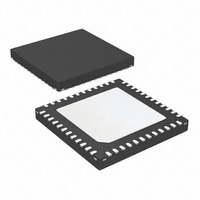AT91SAM7S32B-MU Atmel, AT91SAM7S32B-MU Datasheet - Page 42

AT91SAM7S32B-MU
Manufacturer Part Number
AT91SAM7S32B-MU
Description
IC MCU ARM7 32KB FLASH 48-VQFN
Manufacturer
Atmel
Series
AT91SAMr
Datasheet
1.AT91SAM7S16-MU.pdf
(779 pages)
Specifications of AT91SAM7S32B-MU
Core Processor
ARM7
Core Size
16/32-Bit
Speed
55MHz
Connectivity
I²C, SPI, SSC, UART/USART
Peripherals
Brown-out Detect/Reset, DMA, POR, PWM, WDT
Number Of I /o
21
Program Memory Size
32KB (32K x 8)
Program Memory Type
FLASH
Ram Size
8K x 8
Voltage - Supply (vcc/vdd)
1.65 V ~ 1.95 V
Data Converters
A/D 8x10b
Oscillator Type
Internal
Operating Temperature
-40°C ~ 85°C
Package / Case
48-VQFN Exposed Pad, 48-HVQFN, 48-SQFN, 48-DHVQFN
For Use With
AT91SAM-ICE - EMULATOR FOR AT91 ARM7/ARM9AT91SAM7S-EK - KIT EVAL FOR ARM AT91SAM7S
Lead Free Status / RoHS Status
Lead free / RoHS Compliant
Eeprom Size
-
Available stocks
Company
Part Number
Manufacturer
Quantity
Price
- Current page: 42 of 779
- Download datasheet (11Mb)
11.2
11.2.1
11.2.2
11.2.3
11.2.4
42
ARM7TDMI Processor
AT91SAM7S Series Preliminary
Instruction Type
Data Type
ARM7TDMI Operating Mode
ARM7TDMI Registers
For further details on ARM7TDMI, refer to the following ARM documents:
ARM Architecture Reference Manual (DDI 0100E)
ARM7TDMI Technical Reference Manual (DDI 0210B)
Instructions are either 32 bits long (in ARM state) or 16 bits long (in THUMB state).
ARM7TDMI supports byte (8-bit), half-word (16-bit) and word (32-bit) data types. Words must be
aligned to four-byte boundaries and half words to two-byte boundaries.
Unaligned data access behavior depends on which instruction is used where.
The ARM7TDMI, based on ARM architecture v4T, supports seven processor modes:
Mode changes may be made under software control, or may be brought about by external inter-
rupts or exception processing. Most application programs execute in User mode. The non-user
modes, or privileged modes, are entered in order to service interrupts or exceptions, or to
access protected resources.
The ARM7TDMI processor has a total of 37registers:
These registers are not accessible at the same time. The processor state and operating mode
determine which registers are available to the programmer.
At any one time 16 registers are visible to the user. The remainder are synonyms used to speed
up exception processing.
Register 15 is the Program Counter (PC) and can be used in all instructions to reference data
relative to the current instruction.
R14 holds the return address after a subroutine call.
R13 is used (by software convention) as a stack pointer.
• 31 general-purpose 32-bit registers
• 6 status registers
User: The normal ARM program execution state
FIQ: Designed to support high-speed data transfer or channel process
IRQ: Used for general-purpose interrupt handling
Supervisor: Protected mode for the operating system
Abort mode: Implements virtual memory and/or memory protection
System: A privileged user mode for the operating system
Undefined: Supports software emulation of hardware coprocessors
6175K–ATARM–30-Aug-10
Related parts for AT91SAM7S32B-MU
Image
Part Number
Description
Manufacturer
Datasheet
Request
R

Part Number:
Description:
KIT EVAL FOR ARM AT91SAM7S
Manufacturer:
Atmel
Datasheet:

Part Number:
Description:
MCU, MPU & DSP Development Tools KICKSTART KIT ATMEL AT91SAM7S
Manufacturer:
IAR Systems

Part Number:
Description:
DEV KIT FOR AVR/AVR32
Manufacturer:
Atmel
Datasheet:

Part Number:
Description:
INTERVAL AND WIPE/WASH WIPER CONTROL IC WITH DELAY
Manufacturer:
ATMEL Corporation
Datasheet:

Part Number:
Description:
Low-Voltage Voice-Switched IC for Hands-Free Operation
Manufacturer:
ATMEL Corporation
Datasheet:

Part Number:
Description:
MONOLITHIC INTEGRATED FEATUREPHONE CIRCUIT
Manufacturer:
ATMEL Corporation
Datasheet:

Part Number:
Description:
AM-FM Receiver IC U4255BM-M
Manufacturer:
ATMEL Corporation
Datasheet:

Part Number:
Description:
Monolithic Integrated Feature Phone Circuit
Manufacturer:
ATMEL Corporation
Datasheet:

Part Number:
Description:
Multistandard Video-IF and Quasi Parallel Sound Processing
Manufacturer:
ATMEL Corporation
Datasheet:

Part Number:
Description:
High-performance EE PLD
Manufacturer:
ATMEL Corporation
Datasheet:

Part Number:
Description:
8-bit Flash Microcontroller
Manufacturer:
ATMEL Corporation
Datasheet:

Part Number:
Description:
2-Wire Serial EEPROM
Manufacturer:
ATMEL Corporation
Datasheet:











